

Learn I Ching interpretation. I Ching: Book of Changes / Wilhelm & Baynes Translation. I Ching: Richard Wilhelm Translation. Yarrow Stalks for use with I Ching. The stalks, ties and pouches are not mass-produced and vary somewhat.

Please contact Jane by email jane@eheart.com to make your order. Indicate your preferences for: 1 - extra sturdy or regular sticks (extra sturdy for big hands -- my own stalks are lighter than the regular and have lasted 30 years so far). The stalks are about 8 inches long. While some are green for the first year or so, they all age to a warm wood-color. 2 - Upstate NY herb farm stalks or Vermont stalks from Jane's garden - see photo 3 - three or four of your favorite colors, both for the hand-woven stalk tie and for the pouch (include tan, brown, grey, black, and white as possible choices), as well as colors you don't want me to use.
Cost: $38.00 for stalks with woven tie, pouch, and instruction card Postage and handling for one set (postage rates went up in February 2013) Send check or money order to Jane English, PO Box 90, East Calais, VT 05650 or Make a Paypal payment to jane@eheart.com Thank you for your order. Yarrow Stalks. The Mobile Virtual Yarrow Stalks I Ching.
Virtual Yarrow Stalks. Welcome to Virtual Yarrow Stalks!

Here you can download The Virtual Yarrow Stalks I Ching, read about how to consult the I Ching, browse some books on the subject, and compare 41 different translations. Uploaded 11/27/2008; last updated 10/11/2013. Run this document as a smart phone app! Specific instructions on how to do it on Android here. Includes three translations: Wilhelm/Baynes, Nigel Richmond, and Gregory C. I have no intention of trying to explain the I Ching. Most automated I Ching programs and scripts operate via computer-generated random numbers.
The document, VirtualYarrowStalks.htm/VirtualYarrowStalks.zip, is text-only and easy to save. . • Windows users: you can change the extension from .htm to .hta to simplify the display. Newest pages: The Fractal I Ching generates hexagrams using a simple fractal algorithm. Dynamic Line Energies. The Mathematics of the Ling Qi Jing, a Taoist oracle that dates back to the first few centuries CE. More information . . . Virtual Yarrow Stalks. Welcome to Virtual Yarrow Stalks!
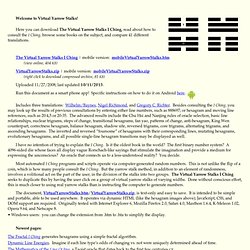
Here you can download The Virtual Yarrow Stalks I Ching, read about how to consult the I Ching, browse some books on the subject, and compare 41 different translations. Uploaded 11/27/2008; last updated 10/11/2013. Run this document as a smart phone app! Specific instructions on how to do it on Android here. Includes three translations: Wilhelm/Baynes, Nigel Richmond, and Gregory C. I have no intention of trying to explain the I Ching. Most automated I Ching programs and scripts operate via computer-generated random numbers. The document, VirtualYarrowStalks.htm/VirtualYarrowStalks.zip, is text-only and easy to save. . • Windows users: you can change the extension from .htm to .hta to simplify the display. Newest pages: Hexagram (I Ching) The I Ching book consists of 64 hexagrams.[1] [2] A hexagram is a figure composed of six stacked horizontal lines (爻 yáo), where each line is either Yang (an unbroken, or solid line), or Yin (broken, an open line with a gap in the center).
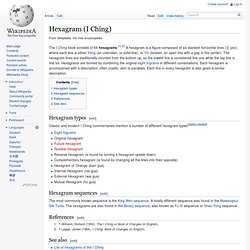
The hexagram lines are traditionally counted from the bottom up, so the lowest line is considered line one while the top line is line six. Hexagrams are formed by combining the original eight trigrams in different combinations. Each hexagram is accompanied with a description, often cryptic, akin to parables. Each line in every hexagram is also given a similar description. Classic and modern I Ching commentaries mention a number of different hexagram types[citation needed]: List of hexagrams of the I Ching. This list is in King Wen order.
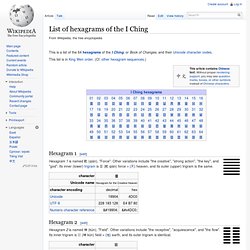
(Cf. other hexagram sequences.) Hexagram 1[edit] Hexagram 1 is named 乾 (qián), "Force". Other variations include "the creative", "strong action", "the key", and "god". Its inner (lower) trigram is ☰ (乾 qián) force = (天) heaven, and its outer (upper) trigram is the same. I Ching. The I Ching, also known as the Classic of Changes, Book of Changes, Zhouyi and Yijing, is one of the oldest of the Chinese classic texts.[1] The book contains a divination system comparable to Western geomancy or the West African Ifá system; in Western cultures and modern East Asia, it is still widely used for this purpose.
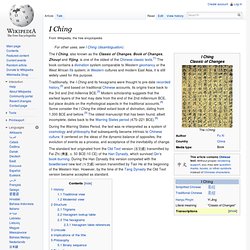
Traditionally, the I Ching and its hexagrams were thought to pre-date recorded history,[2] and based on traditional Chinese accounts, its origins trace back to the 3rd and 2nd millennia BCE.[3] Modern scholarship suggests that the earliest layers of the text may date from the end of the 2nd millennium BCE, but place doubts on the mythological aspects in the traditional accounts.[4] Some consider the I Ching the oldest extant book of divination, dating from 1,000 BCE and before.[5] The oldest manuscript that has been found, albeit incomplete, dates back to the Warring States period (475–221 BCE).[6] History[edit] Traditional view[edit] Modernist view[edit] Structure[edit]
I Ching divination. The process of consulting the book as an oracle involves determining the hexagram by a method of random generation and then reading the text associated with that hexagram, and is a form of bibliomancy.
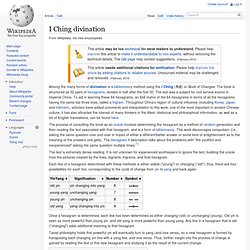
This work discourages compulsion (i.e., asking the same question over and over in hopes of either a different/better answer or some kind of enlightenment as to the meaning of the answers one gets). Sinology Definition.